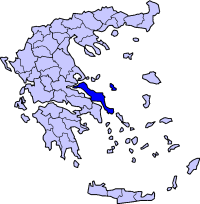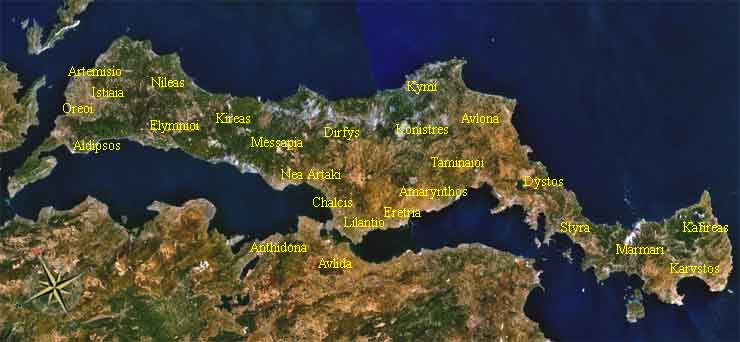|
|
Euboea island, Satellite image of Euboea municipalities (except Skyros)
Amarynthos (Greek: ) is a small a sea-side city, part of the synonymous municipality in Euboea, Greece. The municipality population was 7356 in 2001. The area of the municipality is 109.0 km2. Division of the municipality
Amarynthos is 30 km from Chalkida. and 9 km from Eretria Year Population 1991 3309 In Amarynthos (Ano Vatheia) is the women-monastery of Agios Nikolaos with wallpaintings from the 16th century and the byzantine churches Koimisis tis Theotokou and Metamorfosis. Archaeological studies showed that a settlement existed during the neolithic period 6000 to 3000 BC. Amarynthos was an important settlement in the bronze period 3000 - 2100. The Name Amarynthos is mentioned in Linear B tablets. History The area of Amarynthos, along with the region of Eretria, is wrapping up the most historically interesting region of Euboea. Many scientists place Eretria of the Mycenaean period in the location of the present town of Amarynthos. The archaeological artifacts testify a permanent settlement in this location since the Late Neolithic period, around 3000 BC, which was one of the most important Helladic settlements and a significant port on the island of Euboea, during the Early Bronze Age. It had built its own trade with the Aegean Islands, concluded from the findings of Cycladic art in the region. During the Middle Helladic period, Amarynthos had developed its trade with mainland Greece and produced magnificent pieces of the Minyean art, while in the Late Helladic period it was one of the main areas of Euboea. During the 2nd millennium BC, the Ionians arrived in the southern parts of Greece and settled Euboea, while the name of Amarynthos is mentioned in clay tablets with inscriptions in the Linear B script. Apart from the trade, the locals also occupied with agriculture, pastoralism, fishing and copper processing. In ancient times, there was a festival in Amarynthos called "Amarýnthia", dedicated to Amarysia Artemis, who was worshipped as the patron goddess of Amarynthos and whose shrine was located in the plain of the region, being one of the most important in Central Greece.[4] Parts of it were excavated between 1987 and 1992, hosted now at the Museum of Eretria. In Greek mythology, Amarynthos was a man from Eretria who usually ran after Artemis because of his love to her, and his name was given to the town. Pausanias in his Description of Greece, mentions, along with Amarynthos, a town in Attica called Athmonia, where the Athenians also celebrated Amarysia Artemis in a festival as splendid as the one in Amarynthos (1.31.5). Callimachus says that in Amarynthos, Artemis was worshipped as hornless (kolainis), because Agamemnon sacrificed to her a hornless ram made of wax, while Claudius Aelianus refers to the Eretrians who maimed animals to Artemis at Amarynthos. Strabo, in the Geographica, locates the village of Amarynthos seven stadia distant from the walls of Eretria, to which the village belongs (10.1.10). Amarynthos, like the whole of Euboea, was later ruled by the Macedonians, the Romans, the Byzantines, the Venetians and the Ottoman Turks until it joined the modern Greek state and its economy improved, as Amarynthos was first linked with pavement during the wartime period. In World War II, the Nazi Germany's troops burnt parts of the town, and after the Greek Civil War, its economy grew. After the Greco-Turkish War (1919-1922) and the population exchange between Greece and Turkey, the arrival of Greek refugees from Asia Minor in Euboea, many of which settled in Amarynthos, boosted the population of the town. Location and culture Amarynthos features a beach which makes tourism its main industry other than agriculture and other services, thus several hotels, restaurants, bars and taverns can be found in the town. Amarynthos is built in a plain between the Mount Olympus and Mount Kotylaio. Its surroundings consist of forests which covers large parts of the area, farmlands are within the villages and mountains to the central and the northern parts. Amarynthos has a few schools, a lyceum, a gymnasium, churches, a post office, and a plateia, while its nearest hospital is in Chalcis. Sites of interests What is worth of visiting in the wider area of Amarynthos are the Byzantine churches of "Koimisi tis Theotokou", "Metamorphosi tou Sotiros" and "Zoodochos Pigi", while to the northeast of the town there is the Byzantine monastery of "Agios Nikolaos", with beautiful wall paintings of the 12th century. A Macedonian tomb one kilometre outside of Amarynthos in a location called Vlychos which is dated back to the 4th century BC and was excavated in 1897, a 14th century church named "Panagitsa" close to Ano Vatheia, and the famous "Skoteini Cave" located on a cliff 1.5 kilometre outside of the village Tharounia, are included in the sights of the region.[ Recent incidents Forest fire The forest fire ravaged the town and almost the entire municipality with small sporadic exceptions. The fires on August 24 and 26 came from Aliveri. Its hotels were damaged but its buildings were protected from the fire, the centre of the village was protected by firefighters. Firefighters along with fire trucks and planes that also came from other parts of Europe. The fire lasted several days. Several groves and forests will take several decades to recover to its original level, it also harmed and destroyed its tourist industry.
 |
|
|||||||||||||



